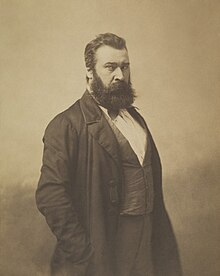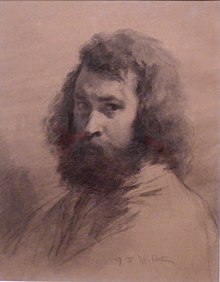Jean-François Millet


Jean-François Millet (born October 4, 1814 in the hamlet of Gruchy in Gréville-Hague , Normandy , † January 20, 1875 in Barbizon ) was a French painter of realism . Alongside Camille Corot , he is one of the leading artists of the Barbizon School .
life and work
Millet was born to wealthy farmers, Jean-Louis Nicolas Millet (from Saint-Germain-le-Gaillard ) and his wife Aimée Henriette Adélaïde Henry. He received school lessons from Abbot Herpent . With the approval and support of his parents, he began his first artistic studies in Cherbourg with the artists Alfred Mouchel and Jean-Charles Langlois. The municipality of Cherbourg awarded him a scholarship which enabled him to continue his studies at the École des Beaux-Arts in Paris with Paul Delaroche . In the Louvre he studied the old masters Andrea Mantegna , Giorgione , Michelangelo and Nicolas Poussin and made drawings based on their models.
The first oil paintings were created in 1837. In 1840 he was represented for the first time with a picture at the Paris Salon . In 1841 he married Pauline-Virginie Ono, who died on April 21, 1844.
Between 1841 and 1847, commuting between Paris and Cherbourg, he made portraits of family members and personalities from Cherbourg as well as paintings with mythological scenes. Although his portraits of those years show a delicate, sensitive treatment of colors and light, he lived in difficult economic circumstances. Especially his mythological scenes , stylistically based on the Rococo , met with derisive criticism from the audience. However, his picture Oedipus from 1847 found the interest and approval of the recognized critic Théophile Thoré ; this compared Millet with the Spanish painters and the brothers Antoine , Louis and Mathieu Le Nain .
However, this picture remained the last of that creative phase. Millet now began to turn to the rural world of work. In the revolutionary year of 1848, his painting Le Vanneur (the grain shaker ) caused a sensation at the Paris Salon: Republican-minded art lovers received it with enthusiastic approval, bourgeois circles react with disgust. Republican Minister Ledru Rollin acquired the picture.

Because of the great cholera epidemic of 1830, Millet moved with his relatives to the village of Barbizon, south of Paris on the edge of the Fontainebleau forest . From the 1850s he was able to live from the sale of his paintings in economically secure circumstances. His realistic pictures of the tough rural working world, for example Les Glaneuses (The Gleaners) from 1857, earned him the reputation of a revolutionary in some. However, he protested against this designation.
With his work Man with the Hoe , he dealt again with the rural working world in 1860–1862. He painted this picture for a salon in 1863.
From 1863 he turned to landscape painting, influenced by his close friend Théodore Rousseau , among others . Pictures such as Printemps (Spring) from 1868–1873 anticipate style elements of Impressionism . In 1867 a large compilation of his works was shown at the World Exhibition in Paris. In 1868 he was awarded the Order of Knight of the Legion of Honor.
In the late years of his life, from around 1865, Millet made a number of pastel drawings. His late landscape paintings and drawings with their mystical light bring him close to symbolism . In 1874 he was commissioned to paint a chapel in the Panthéon . However, he did not get around to completing this work.
François Millet died in Barbizon in January 1875 at the age of 60, exhausted by excruciating coughing and migraine attacks that lasted for weeks and was buried in the cemetery of Chailly-en-Bière , where Théodore Rousseau also rests.
Millet's paintings were and are in some cases very popular, Les Glaneuses (The Gleaners), for example, was often reproduced as art prints and sold as inexpensive wall decorations.
Works (selection)

- 1847: Oedipe détaché de l'arbre par un berger (Oedipus, unleashed from the tree by a shepherd)
- 1848: Le Vanneur (The Grain Swinger ), London , National Gallery
- 1848: Le Vanneur (The Grain Swinger ), Paris, Musée d'Orsay
- 1850: Le Semeur , (The Sower), Boston , Museum of Fine Arts
- around 1850: self-portrait , Vienna, Belvedere
- 1857: Les Glaneuses (The Gleaners), Paris, Musée d'Orsay
- 1857/59: The Angelus , Paris, Musée d'Orsay
- 1858/60: La petite bergère (The Little Shepherd Girl), Paris, Musée d'Orsay
- 1862: The Chailly plain with harrow and plow , Vienna, Belvedere
- 1868/73: Le printemps (spring), Paris, Musée d'Orsay
- 1871/74: L'Église de Gréville (The Church of Gréville), Paris, Musée d'Orsay
- 1872/73: Le parc à moutons, clair de lune
literature
- Robert L. Herbert, Roseline Bacou, Michel Laclotte (Curator): Jean-François Millet . Exhibition catalog, Editions des Musées Nationaux, Paris, 1975
- Dario Durbé, Anna M. Damigella: Corot and the Barbizon School . Pawlak, Herrsching 1988, ISBN 3-88199-430-0 .
- André Fermigier: Jean-François Millet - The discovery of the 19th century . Skira / Klett-Cotta, Stuttgart, 1979, ISBN 3-88447-047-7 .
- Ingrid Hessler: Jean-François Millet - Landscape Representation as a Medium of Individual Religiosity . Dissertation, University of Munich, 1983.
- Estelle M. Hurll: Jean François Millet. A Collection of Fifteen Pictures and a Portrait of the Painter, with Introduction and Interpretation , New Bedford, MA, 1900. [Possible new edition:] ISBN 1-4142-4081-3 .
- Lucien Lepoittevin: Jean François Millet - Au-delà de l'Angélus . Editions de Monza. Paris, 2002, ISBN 978-2-908071-93-1 .
- Lucien Lepoittevin: Jean François Millet - Images et Symboles . Éditions ISOÈTE Cherbourg, 1990, ISBN 2-905385-32-4 .
- Lucien Lepoittevin: Une Chronique de l'amitié. Correspondance intégrale du peintre JFMillet. Le Vast 2005.
- Alexandra R. Murphy: Jean-François Millet . Exhibition catalog, Museum of Fine Arts, Boston, Mass. 1984, ISBN 0-87846-242-2 .
- Alexandra R. Murphy, Richard Rand, Brian T. Allen, James Ganz, Alexis Goodin: Jean-François Millet - drawn into the light . Exhibition catalog, Yale Univ. Press, New Haven, London, 1999, ISBN 0-300-07925-7 .
- Lauren Manouevre: Jean-François Millet - pastels et dessins . Bibliotheque de l'Image, Paris, 2002, ISBN 2-914661-40-1 .
- Alfred Sensier: La vie et l'œuvre de Jean-François Millet . Editions des Champs, Bricqueboscq 2005, ISBN 2-910138-17-8 (new edition of the work from 1881)
- Andrea Meyer: Germany and Millet . Deutscher Kunstverlag, Berlin and Munich 2009. ISBN 978-3-422-06855-1 .
- Hugues Plaideux: L'inventaire après décès et la déclaration de succession de Jean-François Millet. in Revue de la Manche , t. 53, fasc. 212, 2e trim. 2011, b. 2-38.
- Hugues Plaideux: Une enseigne de vétérinaire cherbourgeois peinte par Jean-François Millet in 1841. in Bulletin de la Société française d'histoire de la médecine et des sciences vétérinaires , n ° 11, 2011, b. 61-75.
Web links
- Literature by and about Jean-François Millet in the catalog of the German National Library
- Works by Jean-François Millet at Zeno.org .
- Biography in French
- Artist portrait in German
Individual evidence
- ^ Jean-François Millet - Vincent van Gogh (French), accessed on November 12, 2016
| personal data | |
|---|---|
| SURNAME | Millet, Jean-François |
| BRIEF DESCRIPTION | French painter |
| DATE OF BIRTH | October 4, 1814 |
| PLACE OF BIRTH | Gruchy , Normandy |
| DATE OF DEATH | January 20, 1875 |
| Place of death | Barbizon |


